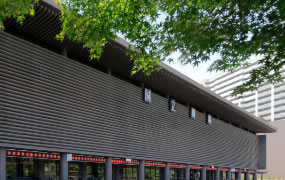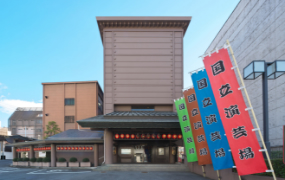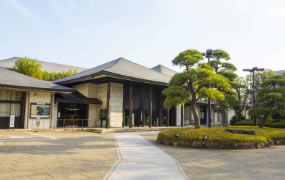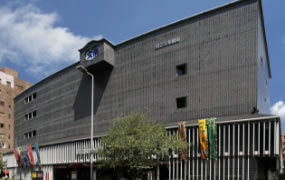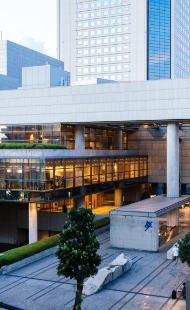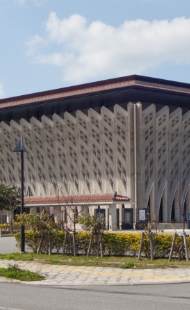Bunraku Performance in December
Performance Dates
December 4 (Wed.) - December 13 (Fri.), 2024 at Koto Culture Centre Hall
*No Performance on 9 (Mon.)
December 17 (Tue.) - December 19 (Thu.), 2024 at Kanagawa Momijizaka Hall
Program Ⅰ (11:00 a.m. – 1:40 p.m.)
Hidakagawa Iriai Zakura
Urikohime to Amanjaku
Kanatsubo Oyaji Koi no Tatehiki
Program II (2:30 p.m. - 5:50 p.m.)
Ichinotani Futaba Gunki
Dannoura Kabuto Gunki
Program III(6:45 p.m. - 8:25 p.m.)
Sonezaki Shinjū
Ticket Prices (tax included)
Adults: [1st Grade] ¥9,000 [2nd Grade] ¥8,000
Students: [1st Grade] ¥6,300 [2nd Grade] ¥5,600
Seating plan (Koto Culture Centre Hall)
Seating plan (Kanagawa Momijizaka Hall)
*Japanese and English audio guides are available for rent. Click here for details of audio guide.
*English synopsis is available. It is included in the paid Japanese brochure.

Booking Opens
November 14 (Thu.), 10:00 a.m.
* If there are still tickets available for purchase on the day of the event, you may purchase them in person at the Box Office (on-site) for this performance.
Box Office (on-site) : Open from 10:00 a.m. until each curtain time.
*Tickets for students and persons with disabilities for this performance are available online.
*Wheelchair spaces are available. For more details, please contact the Box Office.
-----------------------------------------------------------------------------
Box Office (by phone)
0570-07-9900 (From overseas: +81-3-3230-3000) in Japanese and English (10:00 a.m. - 6:00 p.m.)
Click here to find the details about how to buy tickets.
Book Online
-----------------------------------------------------------------------------
in Japanese
Program I
Hidakagawa Iriai Zakura
Kiyohime, who has morphed into a snake, swims across the Hidakagawa River, thinking of her beloved monk, Anchin. This scene, based on the Legend of Dōjōji, conveys the full appeal of this performance in which only puppets are capable of the movements, as well as that of Gidayū-bushi.
Urikohime to Amanjaku
As Urikohime is weaving, the prankster Amanjaku appears and draws close to her. He then binds Urikohime to a tree and successfully disguises himself perfectly as Urikohime. Knowing she is to see her grandparents Jissa and Bassa who have just come back, Amanjaku can’t suppress his desire to cause some mischief. However…
This piece was written by KINOSHITA Junji (1914-2006) ― the playwright known for “Yūzuru,” “Shigosen no Matsuri” and others. As a masterpiece of remarkable, colloquial-style Jōruri depicting a mountain village at dusk, it has been frequently performed at the National Bunraku Theatre in Osaka, to very favorable reviews. This marks the first time it is being performed in the Tokyo metropolitan area in 63 years, by popular demand of the arts aficionados here.
In Commemoration of the 90th Anniversary of INOUE Hisashi’s Birth
Kanatsubo Oyaji Koi no Tatehiki
― Based on “L’Avare” by Molière ―
Kananakaya Kinzaemon, the master of a Kananakaya kimono shop, is a matchless miser obsessed with money. It just so happens that money-mad Kinzaemon and his daughter Otaka are both offered a marriage proposal, which throws the kimono shop into an uproar.
INOUE Hisashi (1934-2010) ― whose various works include “Nihonjin no Heso” and “Zutsū Katakori Higuchi Ichiyō” ― adapted the drama “L’Avare” by Molière into this Gidayū-bushi piece especially as a broadcast program. The great commotions caused by the greedy Kinzaemon are represented in the writing style full of the lively wit unique to INOUE.
Program II
Ichinotani Futaba Gunki
The Genji warlord Kumagai Naozane slays Taira no Atsumori, who is only 16 years old, in battle with the Heike clan. Atsumori’s mother, Fuji no Tsubone, presses Naozane’s wife Sagami to help her kill Naozane to avenge her son’s death. Having returned to Kumagai’s camp, Naozane talks to Fuji no Tsubone about Atsumori’s last moments. Later, the Genji general Yoshitsune inspects the head of Atsumori and something totally unexpected is revealed…
This is a jidaimono masterpiece themed on feelings of grief and uncertainty ― as a warrior and as a parent ― of Kumagai Naozane, who sacrificed his own son in a bid to faithfully follow the secret order from Yoshitsune.
Dannoura Kabuto Gunki
Following the fall of the Heike clan, in a bid to locate the hideout of Akushichibyōe Kagekiyo ― a samurai-daishō (samurai who leads troops in battle) in the Heike clan, Hatakeyama Shigetada on the Kamakura side tries to interrogate Akoya, the fugitive’s lover. To find out if she knows the whereabouts of Kagekiyo, Shigetada orders Akoya to play three kinds of instruments ― the koto, shamisen, and kokyū ― thinking that she will not be able to concentrate on her performance and play well if she is hiding something about Kagekiyo. The music with koto, shamisen, and kokyū adds color to this courtroom drama ― a peculiar stage setting for Bunraku ― with its splendid melodies, all under the guise of the heartbreaking sorrow of Akoya, who reminisces about her lover while fearing for his future.
Program III
Sonezaki Shinjū
This is a Sewa Jōruri piece based on a double suicide that took place at the Tsuyunotenjinsha, Sonezaki Shinchi shrine, adapted by Chikamatsu Monzaemon. Soon after its premiere in 1703, the performance came to halt; however, a trend toward its revival has come about in more recent times. When it was presented in 1955, it immediately became a hit and remains the most popular piece of Bunraku even today.
In the tale, Tokubē, a clerk at a Hiranoya shōyu wholesaler, is swindled out of some money ― which he was supposed to pay back to his master ― by Kuheiji. Depressed, Tokubē secretly visits Ohatsu, his favorite courtesan at Tenmaya. Ohatsu hides him under the floorboards. Not only being unable to fulfill his duty to his master but also having lost the trust of the public, Tokubē feels desperate. To convey to Ohatsu that he is ready to die, he takes her ankle and moves it to his throat like a knife. The last journey of the couple, who have pledged to marry in the next world, is beautifully depicted with the rhythmic flow of the words, “We leave behind this world and we leave behind the night…”


